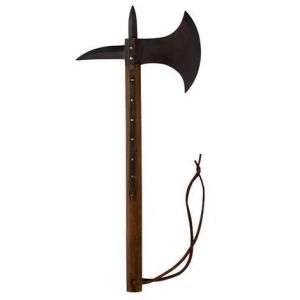
The medieval axe was used as a lethal weapon in battle, a defensive tool, a tool of daily life, and a symbol of power and status. This dual role underlines their importance in the medieval era, serving essential functions in both peace and conflict. Axes were tools of daily life used for tasks such as chopping wood or construction. Thrown in a spinning motion, this axe introduced an unpredictable element in battle, capable of disrupting enemy formations from a distance.īut the use of the medieval axe was not limited to warfare. The Francisca, a specialized throwing axe, brought a different dynamic to the battlefield. The bearded axe’s curved edge could even hook an opponent’s shield or weapon, creating an opening for a counterattack. The shaft of an axe could be used to parry blows, and the head could potentially trap an opponent’s weapon. On the other hand, the long-handled Dane axe was particularly effective against shields and chainmail. The broadaxe, with its wide blade, was designed specifically to hack through the thick armor of enemy combatants. It was a force to reckon with in close combat, where its weight and balance could deliver crushing blows capable of penetrating armor or shattering shields. In the sphere of warfare, the battle axe was a formidable weapon.

Its uses ranged from the mundane to the fiercely combative, each influenced by the specific type of axe and the situation at hand.

The medieval axe, a key component in Middle Ages warfare, was a tool of both versatility and devastating power. Nevertheless, these terminologies help distinguish the various battle axes utilized during the medieval era, each uniquely shaping warfare dynamics. It’s essential to note that the terminology could vary regionally or depending on the specific historic sources referenced. The “Poleaxe,” with its longer shaft, was created primarily for combating mounted knights. The “Broadaxe” featured a broad blade designed to hack through thick armor, while the “Bearded Axe” had a sharp, curved edge extending downwards from the blade, making it useful in both combat and daily life.Īt the same time, the “Francisca” was a throwing axe employed by the Franks, designed for spinning when thrown, creating unpredictability in battle. The medieval axe, a vital weapon in the arsenal, is broadly termed a “battle axe.” However, various design differences and functionalities have led to multiple specific types of battle axes, each bearing unique names reflecting their purpose or origin.įor instance, the “Dane Axe” was used widely by Viking warriors, renowned for its long handle and large blade. This article delves into the intriguing history of Middle Ages battle axes, exploring their development, usage, types, and enduring legacy. Its heavy blade, often paired with a sturdy handle, made it an imposing instrument of warfare, while its utility value transformed it into an emblem of the medieval era. Warriors utilized a wide array of weapons, among which the historical medieval battle axe holds a special place. The Middle Ages, spanning roughly from the 5th to the 15th century, was a period of prolific and intense warfare.


 0 kommentar(er)
0 kommentar(er)
